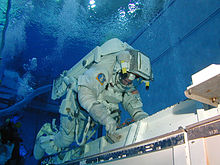- Neutral Buoyancy Laboratory
-
 NBL Logo
NBL Logo
The Neutral Buoyancy Laboratory (NBL) is an astronaut training facility maintained by and located at the Sonny Carter Training Facility on NASA's Johnson Space Center in Houston, Texas.[1] The NBL consists of a large indoor pool of water, the largest in the world,[2] in which astronauts may perform simulated EVA tasks in preparation for upcoming missions. The NBL contains full-sized mock-ups of the Space Shuttle cargo bay, flight payloads, and the International Space Station (ISS).[3]
The principle of neutral buoyancy is used to simulate the weightless environment of space.[1] First the suited astronauts or equipment is lowered into the pool using an overhead crane. Once this is done the suited astronauts weighted in the water by support divers so that they experience no buoyant force and no rotational moment about their center of mass.[1] The suits worn in the NBL are down-rated from fully flight-rated EMU suits like those in use on the space shuttle and International Space Station.
The NBL tank itself is 202 feet (62 m) in length, 102 feet (31 m) wide, and 40 feet 6 inches (12.34 m) deep, and contains 6.2 million gallons (23.5 million litres) of water.[3][4] Divers breathe nitrox while working in the tank.[5][6]
One downside of using neutral buoyancy to simulate microgravity is the significant amount of drag presented by water.[7] Generally, drag effects are minimized by doing tasks slowly in the water. Another downside of neutral buoyancy simulation is that astronauts are not weightless within their suits, thus, precise suit sizing is critical.
Contents
Alternative microgravity simulators
The other primary method used by NASA to simulate microgravity is the so-called "Vomit Comet", an aircraft which performs a number of parabolic climbs and descents to give its occupants the sensation of zero gravity.[8] The vomit comet reduces the problem of drag in weightless simulation. The main shortcoming of this method is its time limitations - periods of weightlessness are limited to around 25 seconds, interspersed with periods of acceleration of around 2 g as the aircraft pulls out of its dive and readies for the next run.[9] This is obviously not suitable for practicing EVAs, which usually last several hours.
Non-NASA, non-US-government neutral buoyancy facilities
The Neutral Buoyancy Research Facility at the University of Maryland's Space Systems Laboratory performs research into EVA techniques and robotic interaction using neutral buoyancy as a basis for weightless simulation.[10] Equipment is lowered into the pool using an overhead crane.[11]
 Panorama of the NBL in Houston, Texas
Panorama of the NBL in Houston, Texas
See also
References
- ^ a b c Strauss S (July 2008). "Space medicine at the NASA-JSC, neutral buoyancy laboratory". Aviat Space Environ Med 79 (7): 732–3. PMID 18619137.
- ^ "Behind the scenes training". NASA. May 30, 2003. http://spaceflight.nasa.gov/shuttle/support/training/nbl/facilities.html. Retrieved March 22, 2011.
- ^ a b Strauss S, Krog RL, Feiveson AH (May 2005). "Extravehicular mobility unit training and astronaut injuries". Aviat Space Environ Med 76 (5): 469–74. PMID 15892545. http://www.ingentaconnect.com/content/asma/asem/2005/00000076/00000005/art00008. Retrieved 2008-08-27.
- ^ "NBL Characteristics". About the NBL. NASA. June 23, 2005. http://dx12.jsc.nasa.gov/about/index.shtml.
- ^ Fitzpatrick DT, Conkin J (2003). "Improved pulmonary function in working divers breathing nitrox at shallow depths". Undersea Hyperb Med abstract 30 (Supplement). http://archive.rubicon-foundation.org/1273. Retrieved 2008-08-27.
- ^ Fitzpatrick DT, Conkin J (July 2003). "Improved pulmonary function in working divers breathing nitrox at shallow depths". Aviat Space Environ Med 74 (7): 763–7. PMID 12862332. http://www.ingentaconnect.com/content/asma/asem/2003/00000074/00000007/art00011. Retrieved 2008-08-27.
- ^ Pendergast D, Mollendorf J, Zamparo P, Termin A, Bushnell D, Paschke D (2005). "The influence of drag on human locomotion in water". Undersea Hyperb Med 32 (1): 45–57. PMID 15796314. http://archive.rubicon-foundation.org/4037. Retrieved 2008-08-27.
- ^ Rafiq A, Hummel R, Lavrentyev V, Derry W, Williams D, Merrell RC (August 2006). "Microgravity effects on fine motor skills: tying surgical knots during parabolic flight". Aviat Space Environ Med 77 (8): 852–6. PMID 16909881. http://www.ingentaconnect.com/content/asma/asem/2006/00000077/00000008/art00011. Retrieved 2008-08-27.
- ^ Pletser V (November 2004). "Short duration microgravity experiments in physical and life sciences during parabolic flights: the first 30 ESA campaigns". Acta Astronaut 55 (10): 829–54. doi:10.1016/j.actaastro.2004.04.006. PMID 15806734.
- ^ University of Maryland. "Space Systems Lab: Neutral Buoyancy Research Facility". http://ssl.umd.edu/facilities/index.shtml#NBRF. Retrieved 2008-08-27.
- ^ Science discovery channel. "How do they do it". http://science.discovery.com/videos/how-do-they-do-it-space-training-astronauts.html. Retrieved July 17, 2009.
Categories:- Neutral buoyancy facilities
- Lyndon B. Johnson Space Center
- Human spaceflight
Wikimedia Foundation. 2010.


